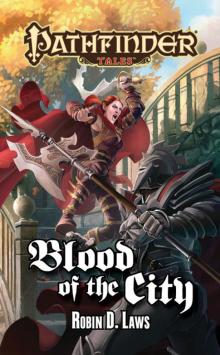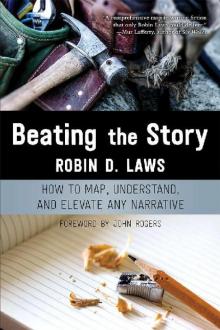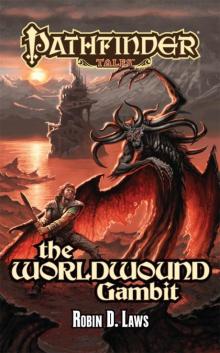- Home
- Robin D. Laws
Beating the Story Page 10
Beating the Story Read online
Page 10
Trajectory
If we zoom out to look at the trajectory of the entire beat map, we see a steady downward slope, its descent slowed by a leavening of up beats throughout.
This is the same pattern we see again and again, whether the story ends on the triumph expected in contemporary Western pop culture, or the slam of cruel irony favored by Maupassant and those influenced by him.
Transition Breakdown
When we look at the transitions alone, we see the following:
First, we see very few transitions. Unsurprising for a short story.
Most notably, the majority of the transitions (two-thirds if you want to be exact about it) are Outgrowths, the transition most associated with strong momentum. The rest are Continuations—also unsurprising, as the story’s protagonist, Mathilde, remains the focus character for all but one or two beats. (The few beats where Loisel takes focus occur within a quick sequence in which his wife also appears.) Further, these Continuations bookend the story, with the majority of it consisting of a single flow of events over time and locale.
The tightness and unity called for by the short story format makes it relatively easy to stick to Outgrowths and Continuations. And Maupassant is tighter and more unified than most, which is in part why I chose this story as our first example.
Longer works featuring more elaborate plotting, multiple plot threads, or both will prompt you to dig deeper into the list of possible transitions. But the short story is all about getting in, laying down exactly the number of beats you need to tell the story, and getting back out again.
4
Laying the Groundwork
Every writer prepares differently for the first draft. You may find beat analysis useful before you start, or as an analytical tool to apply after finishing that draft, or even a later one.
Established writers reading this book almost undoubtedly already know how much preparation they need before starting, and what precise form that groundwork takes. Except in the unlikely case that you’re looking to burn down your method and rebuild it from the bottom up, you’ll want to skim from here to “Mapping Your Story.”
Emerging writers who have yet to settle on a prep routine may wish to consider the choices raised in the rest of this section.
Diving Right In
Some writers work by diving right in to the first draft, writing in an exploratory fashion and then revising extensively. Over many drafts a finished manuscript emerges, as the writer, perhaps working purely intuitively, finds themes and throughlines. Entire characters, sections, and subplots may be added or jettisoned in a multi-year process of discovery, shaping, and reshaping. The initially instinctive, “organic” process of writing gradually transitions into the analytical, editorial exercise of tearing down and rebuilding, perhaps in heavy collaboration with a trusted editor. For reasons both creative and pragmatic, writers of literary fiction generally prefer this approach.
Works composed seat-of-the-pants style may defy formula or evoke the messiness of lived experience.
When working without an outline, likely challenges you’ll want to ready yourself for include:
Significantly longer writing time, encompassing many more drafts.
False starts. You may find yourself writing the first twenty pages of many different projects, only to peter out on them when the initial impetus that started you exhausts itself, or the plot leads to a dead end.
The temptation to leave in sequences that don’t fit your throughline. You may fight to keep them because they work well in isolation, you’ve fallen in love with them, or you remember how hard you sweated to write them in the first place.
Outlining
Writers in commercial genres, which demand shorter works, delivered in quicker succession, are more likely than literary writers to rely heavily on outlines and treatments before getting started. Those working for clients, whether they be television or movie producers, or editors of tie-in fiction, or fiction devised to fit a tightly defined formulaic model, usually have to submit outlines before moving to the first draft stage. Their editors will also expect a warning of any significant deviations from the outline they might want to make during the writing process.
Potential pitfalls to guard against if you choose the outline method include:
overly schematic narrative, in which the reader can easily spot the familiar or over-determined first principles you built out from
finding that a sequence that worked in summary format makes no sense or is otherwise unsatisfying when fully composed
predictability of effort, where the initial joy of pure creation is frontloaded into a few weeks of outlining, leaving only small surprises during the hard slogging months of actual execution
As the author of multiple books and games that break narratives down into their component parts, you may be unsurprised to discover that I personally fall into the outliner category for anything longer than a short story. (Even for short stories I compose a tight outline in my head and know the two or three key sequences I want to write and why I want to write them.)
If you are tempted by the outline side but fear the predictability-of-effort problem, I can attest that I have never written from a detailed outline and not been surprised by better, richer, more textured ways to deliver its beats during the first draft phase.
Which To Choose?
I would never presume to tell you, emerging writer, what method you should settle on to drive the rest of your writing life. Every creator finds her own way of enlivening, understanding, and ultimately bringing to full fruition that lightning moment of initial inspiration.
But if we met at a conference and you bought me a beer and then maybe an ultra-premium tequila and then let’s say another round, I’d say:
Do the seat of the pants thing if you’re a literary writer. In any commercial genre in which time is money, outline.
And if you’re a literary writer, you might still want to outline in the privacy of your own office. Do you have to mention in interviews that you own, or got anything out of, this book? No, you do not. Those who demand of the writer a hermetic, secretive process should get it—even if your secrets involve diagrams with lots of arrows in them.
Adaptation
Adapting a work from one medium into another is inevitably a process of analysis and planning. The original piece functions as a full draft, which you must then understand and reconfigure to the strengths and limitations of the new medium. After reading and rereading the piece until you become fully familiar with it, you’ll want to pinpoint its core elements, as already set out in “Conceiving Your Story”:
throughline
core question
boil-down
theme
protagonist(s)
the protagonist’s type (dramatic or heroic)
if heroic, the subtype (transformational or iconic)
if dramatic, the character’s dramatic poles and the resolution of those poles
Knowingly or otherwise, the choices you make when defining these elements lay the foundation for your personal take on the work.
When adapting your own work you have in one way or another answered these questions, but may find it fruitful to revisit your early notes and/or outline as a reminder before proceeding.
Adaptations sometimes expand the original work but more often condense it. As you review the piece again, highlighting the key moments that absolutely must appear in any respectable adaptation, note how they relate to the core question and throughline.
Your outline may take the form of a written treatment, or simply a series of index cards (physical or virtual) naming the key sequences. You might create a rough outline by cutting and pasting snippets or passages from the original into a new document. The underlying narrative already exists so you’re essentially building a pile of reminders to get you f
rom the original to a new treatment.
When a sequence doesn’t make sense or falls flat shorn of its previous context, perform a beat analysis on the original and on your rearranged version. From the comparison you will likely spot the changes to emotional rhythm, or the missing informational beats, that altered the temperature of the piece.
If you’re fearing that this process might be reductive, killing a complex original piece through over-analysis, remember that the full piece, including the subtleties and ambiguities that drew you to it in the first place, remains in your mind from your reading and rereading. Right now you’re studying the piece’s foundations, so you can build a slightly different iteration of it. Later you’ll layer in those grace notes and paradoxes, on an underpinning you know will support them. Those crossed arrows will show up soon enough.
Perhaps more challenging is the task of expanding a story told in a brief or simple format into a longer one requiring additional elaboration. By identifying its core elements before you start to build the additional incidents needed for an expanded narrative, you can ensure that those new interpolations do not register as mere filler but rather seamlessly express the defining qualities of the original piece.
Finding Your Structure
Most guides to the fiction writing process focus heavily on structure—the relative positioning of major breaks and turns within the narrative.
This book, and the beat analysis system in general, remain staunchly agnostic on the subject of which structure you ought to use for your story—except to say that you should have one, or understand why you’ve chosen not to.
Some markets, and the formats associated with them, dictate a very particular structure. In ad-supported television you will write toward a set number of act breaks, with or without the flexibility to adjust the lengths of acts.
Readers of film scripts expect a certain structure, more or less defaulting to the three-act setup described by Syd Field in his influential guide Screenplay.
Even more precisely elaborate structures may tell you to show your screenplay’s protagonist doing something sympathetic before you reach a given page number.
Certain romance fiction lines likewise very specifically dictate a structure built around particular story beats the audience demands.
Novels in other genres allow much greater flexibility, letting you choose a structure that fits the content rather than working toward a reliable workhorse of a framework. Too obvious a structure may make your prose piece feel like the treatment for an unproduced screenplay.
Standardized structures wear out over time only to be renewed and replaced.
Over the course of the sound era, Hollywood films have gone from snappy to epically extended to experimental to formulaic to sprawling and decentered and are no doubt already heading somewhere else by the time you read this. The most remarkable films are often those that appear to follow no standard structure at all but maintain momentum through some ineffable sleight of hand. This may in fact be the case: they’re choosing transition types so deftly that the audience is carried along without the need for a broader structure to propel them. Alternately, their writers may have hidden the standard turns and pivots so adeptly that you can’t spot them on first viewing.
In general, thinking about structure inspires you to contemplate the following questions, the answers to which will illuminate your outline (if you use one) or your wave of revisions after completing the first draft (if you don’t).
Does my story provide variation by confronting its protagonist(s) with major surprises or changes in direction?
Are those turns spaced far enough apart to let their impact be felt?
Does my story include long static stretches where nothing much changes?
Do the big developments of the narrative cluster together, leaving no space for their emotional impact to register?
Does the story escalate in stakes, suspense and/or emotional intensity, then move toward a satisfying climax or resolution?
Your chosen genre and specific intentions may trigger other structural questions. If your aim is to follow a mythic pattern, like Joseph Campbell’s hero’s journey or a recapitulation of Arthurian legend, you’ll want to check to see that your story includes all of its classic stages.
When mapping your beats, you may then wish to include a marker or notation for each of your structural breaks.
To conclude:
This book doesn’t spend much time on structure.
Structure is good.
Except when you really know what you’re doing.
Regardless of the structure you’re using (including no structure), beat analysis helps you create and/or revise the moments arranged within its pivot points.
Blocked Desires
Before embarking on a primarily dramatic work, crystallize its energizing conflicts by preparing notes on the protagonists’ blocked desires.
Emotional conflicts, arising from unmet needs, form the basis of any dramatic story. The process by which these needs are resolved or proved definitely irreconcilable constitutes the incident of your narrative. As the preparatory step to constructing those incidents, create a diagram featuring your key characters, visually laying out the unmet needs between them.
An emotional conflict consists of two components: the Desire and the Block.
The Desire is the emotional reward one character seeks from another.
The Block is the reason why the other character will not meet that desire.
Let’s pick up one of the ideas we randomly generated back under The Random Actor Method: an academic marries the son of her famously reclusive literary idol and attempts to pull her from her spiral of self-destruction.
To clarify the example, let’s assign names to the characters:
Holly Moss, the academic.
Juliette Reyna, the mother-in-law.
Tom Reyna, the son.
The premise establishes what Holly wants from Juliette—that she return to her previous self, the renowned author she studies and idolizes. That’s Holly’s Desire for Juliette.
Why would Juliette resist this? She retreated from writing and the world because the stress of living up to her past successes made her an emotional terror to the people around her—particularly Tom. She hopes to reconcile with her son, which means she has to show that every last vestige of her previous, ragingly insecure person is gone. That’s Juliette’s Block of Holly’s Desire.
The two sides of this conflict heavily imply what the remaining Desires and Blocks will look like. So you continue to flesh them out, sticking with Holly for the moment.
Her Desire for Tom is that he back her attempt to bring Juliette out of her shell. His Block for her Desire is that bringing back the old version of Juliette, who terrified him as a child, is the last thing in the world he wants.
What does Juliette want from Holly? She wants Holly out of the way so she can attempt to reconcile with her son. Holly Blocks this because she wants the famous Juliette back.
You’ve already established that Juliette’s Desire for Tom is reconciliation. He Blocks this because he wants to avoid her, and to be with Holly.
Tom’s Blocks are now all determined; to find his Desires, just turn them on their heads.
His Desire for Holly is to show her that she can’t fix his mother. Her Block: she has decided to do just that—and has persuaded herself that this will be good for Tom, too.
His Desire for Juliette is to show she no longer has power over him and then escape. Juliette Blocks this because she wants him back, not gone for good.
A table format helps you find the fault lines in these six relationships at a glance. When you decide to outline or write a scene involving two of them, you can quickly find a petition one might make of the other, and build the scene out from there.
After a turni
ng point in the narrative you might determine that one or more of these relationships has moved onto a new stage, with an adjusted Desire and/or Block. Depending on how useful you find this table as an ongoing reference, you might fill out a new one, or rely on your memory of the evolving emotional dynamics to propel you through the draft or outline.
You may decide that certain relationships needn’t give rise to conflict. The larger your cast, the more you’ll want to avoid overloading your table with entries. Less fraught relationships give you the foundation for scenes of respite or alliance, and thus up beats that leaven the intensity of scenes developing your primary relationship. As long as your central conflict gives you sufficient grist for scenes, this process has done its job.
Nor must every web of relationships need to evoke heavy feeling. This structure works regardless of your chosen tone and stance—it could as easily apply to a comedy or heartwarming family story as the tale of family dysfunction we’ve just sketched out here.
Laying these tensions in bald point form may cause you to worry that you’ve devised something obvious or heavy-handed. However, these notes refer not to what the characters say about their desires, or even what they understand about them. These notes comprise the basic subtext underlying the scenes themselves. As you write your scenes, you will layer them with the outward expressions and emotional tactics we all use to moderate and conceal our objectives, especially when dealing with people we care about. Those nuances and telling details will form the text of your dramatic scenes.

 Blood of the City
Blood of the City Beating the Story
Beating the Story Plague of Light
Plague of Light The Worldwound Gambit
The Worldwound Gambit